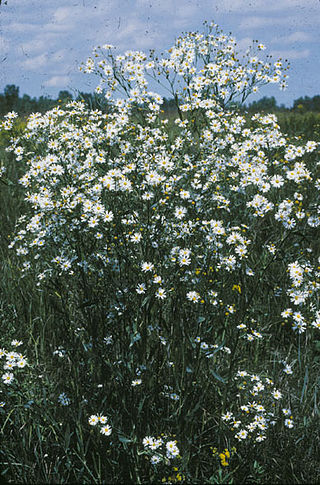
Boltonia asteroides, the white doll's daisy, false chamomile, or false aster, is a species of plant native to the United States and Canada. It is found primarily in the Mississippi Valley and Great Plains from Saskatchewan south to Texas and Florida, with isolated populations in the eastern United States. Reports of the species in New England, New York, and the Pacific Northwest appear to be introductions.
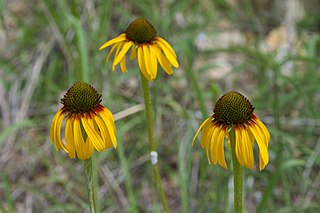
Echinacea paradoxa, the yellow coneflower, Bush's purple coneflower, or Ozark coneflower, is a North American species of flowering plant in the family Asteraceae. It is native to southern Missouri, Arkansas, and south-central Oklahoma. It is listed as threatened in Arkansas.
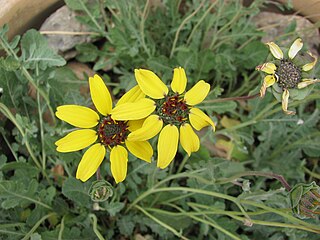
Berlandiera is a genus of flowering plants in the family Asteraceae.

Symphyotrichum lateriflorum is a species of flowering plant in the aster family (Asteraceae). Commonly known as calico aster, starved aster, and white woodland aster, it is native to eastern and central North America. It is a perennial and herbaceous plant that may reach heights up to 120 centimeters and widths up to 30 centimeters.
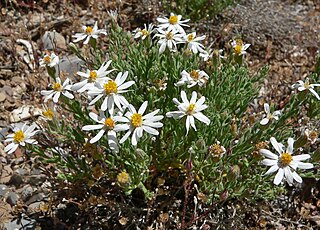
Chaetopappa is a genus of plants in the family Asteraceae which are known generally as leastdaisies.

Helenium amarum is a species of annual herb in the daisy family known by the common names yellowdicks, yellow sneezeweed, fiveleaf sneezeweed, and bitter sneezeweed. It is native to much of the south-central United States and northern Mexico, and it is present elsewhere in North America, Australia, and the West Indies as an introduced species.

Agoseris grandiflora is a North American species of flowering plant in the family Asteraceae known by the common names California dandelion, bigflower agoseris, and grassland agoseris.

Liatris elegans, known commonly as pinkscale gayfeather, pinkscale blazingstar, and elegant blazingstar, is a species of flowering plant in the family Asteraceae. It is native to the southeastern United States as far west as Texas and Oklahoma.

Croptilon is a small North American genus of flowering plants in the tribe Astereae within the family Asteraceae.
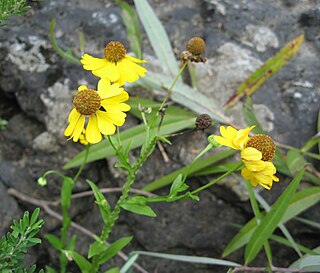
Helenium flexuosum is a North American plant species in the daisy family known by the common name purple sneezeweed. It is widespread across much of eastern and central United States and Canada, from Nova Scotia west to Ontario, Minnesota, and Kansas, south to Florida, Louisiana, and eastern Texas.
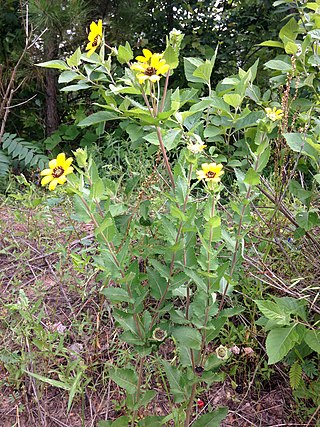
Berlandiera texana is a North American species of flowering plant in the family Asteraceae. It is commonly known as Texas greeneyes. It is native to the south-central United States, in the states of Texas, New Mexico, Oklahoma, Kansas, Missouri, Arkansas, and Louisiana.

Bradburia pilosa, the soft goldenaster, is a North American species of flowering plants in the family Asteraceae, native to the south-central United States, primarily the southeastern Great Plains and lower Mississippi Valley, in the states of Texas, Oklahoma, Kansas, Missouri, Arkansas, Louisiana, Tennessee, Mississippi, and Alabama. Additional populations are reported farther east but these appear to be introductions. Its habitats include disturbed roadsides and pine-oak-juniper woods.

Carphephorus odoratissimus, common name vanillaleaf, is a species of North American plants in the family Asteraceae. This species is native to the southeastern United States, including the states of Georgia, North Carolina, South Carolina, Alabama, Mississippi, Louisiana, and Florida.

Cirsium texanum is a species of plant in the tribe Cardueae within the family Asteraceae found in North America. Common names include Texas thistle, Texas purple thistle or southern thistle. The species is native to northern Mexico and the southern Great Plains of the south-central United States. It grows in prairies and roadsides.

Croptilon rigidifolium, called the stiff-leaf scratchdaisy, is a North American species of flowering plants in the tribe Astereae within the family Asteraceae. It has been found in the US State of Texas and also in the Mexican State of Nuevo León.

Croptilon divaricatum, called the slender scratchdaisy, is a North American species of flowering plants in the tribe Astereae within the family Asteraceae. It is native to the southeastern and south-central United States, in the states of Texas, Oklahoma, Arkansas, Louisiana, Mississippi, Alabama, Florida, Georgia, Virginia, and the Carolinas.
Ericameria compacta, the Charleston Mountain goldenbush, is a rare North American species of flowering plants in the family Asteraceae. It has been found only in pine forests in the Spring and Sheep Mountains of Clark County, Nevada. Fewer than 12 populations have been found.

Erigeron bellidiastrum, the western daisy fleabane or sand fleabane, is a species of fleabane in the family Asteraceae. It is native to northern Mexico and the western and central United States.
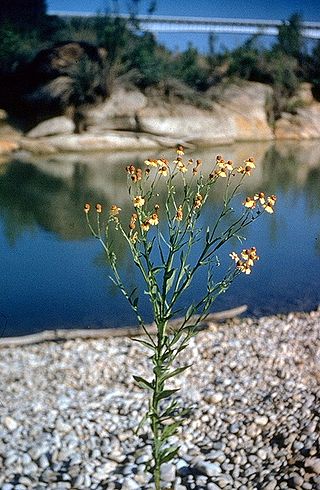
Helenium elegans is a North American perennial plant in the sunflower family, commonly known as pretty sneezeweed. It is native to the south-central United States and to northeastern Mexico.

Symphyotrichum divaricatum is an annual and herbaceous plant commonly known as southern annual saltmarsh aster. It is native to the southern United States and some northern states of Mexico.



















